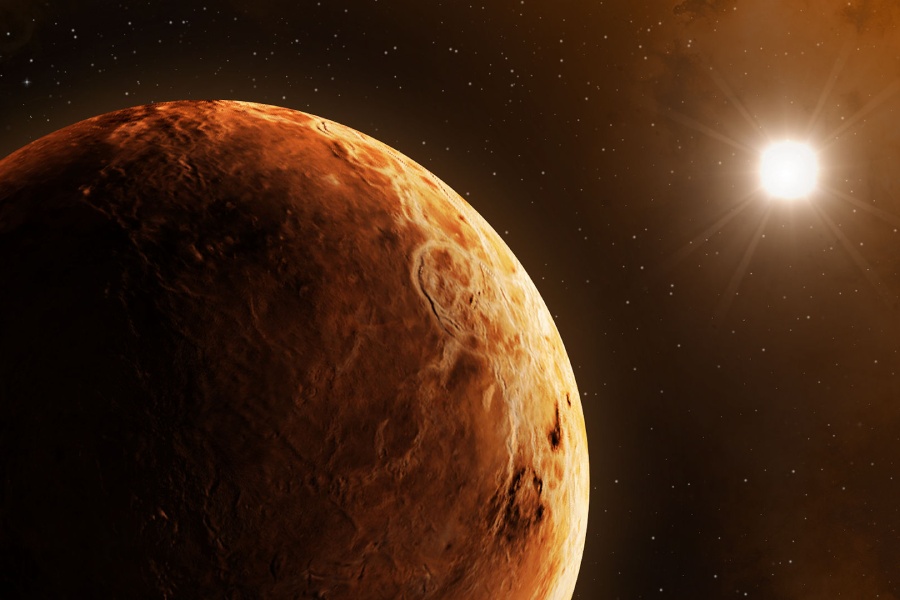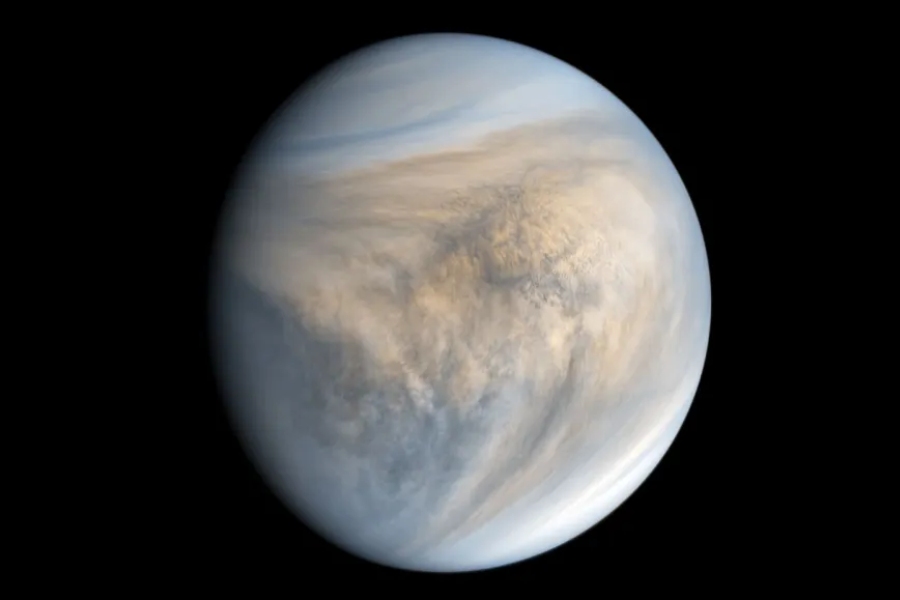Venus, often referred to as Earth’s twin, has long captivated scientists and stargazers alike with its enigmatic allure. Among the many questions surrounding this celestial neighbor, one inquiry stands out prominently: does Venus have water, the fundamental ingredient for life as we know it?
In this article, we’ll compare findings from past Venus missions, revealing clues about this world’s watery past. We’ll look at potential modern-day sources like subsurface aquifers, atmospheric moisture, and traces detected in surface chemistry.
Join us as we delve into Venusian mysteries, where the search for water holds profound implications for planetary evolution!

Does Venus Have Water?
No, Venus doesn’t have liquid water on its surface because it’s extremely hot and enveloped by a thick carbon dioxide atmosphere. The scorching conditions on Venus make it impossible for liquid water to exist there.
Despite this, scientists have discovered indications hinting at the presence of trace amounts of water vapor in Venus’ atmosphere. Although Venus lacks liquid water like Earth, some water vapor may linger high in its atmosphere.
Surface Conditions of Venus
The extreme atmosphere
The atmosphere of Venus is primarily composed of dense, heavy carbon dioxide. The surface pressure is around 92 times higher than that on Earth – equivalent to the pressure more than a mile under the sea.
This dense atmosphere traps heat from the Sun very effectively. As a result, Venus has the highest surface temperature of any planet in the Solar System, around 864 degrees Fahrenheit (462 degrees Celsius).
What about seasons? Does Venus have seasons? Yes, Venus has seasons, but they are very different from Earth’s due to its dense atmosphere and thick cloud cover. With almost no variation in sunlight, Venus makes it through the clouds to the surface throughout the year, experiencing quite mild lower altitude changes.
However, at higher elevations, the planet shows more seasonal shifts from altering solar irradiance through its orbital cycle. There are more pronounced seasons higher up in the atmosphere as atmospheric circulation shifts throughout the year, moving clouds around. Winds speed up and slow down during different Venusian seasons.
The hostile surface
The intense greenhouse effect on Venus means that there is no liquid water on the surface. The extreme heat is enough to melt lead, damaging any spacecraft attempting to study the surface. The dense atmosphere also obscures views of the rocky surface, though radar mapping has revealed some surface features in detail.
Why the surface conditions are so harsh
As mentioned, carbon dioxide makes up the bulk of Venus’ atmosphere, causing an intense greenhouse effect that keeps heat trapped. With minimal atmospheric circulation, the Sun’s heat cannot escape once the light penetrates.
Venus likely lost its water long ago, leaving a dense carbon dioxide atmosphere behind it. This led to a feedback loop over time, progressing toward the inhospitable climate seen on Venus today.
Evidence for Liquid Water on Venus in the Past
Indications of water in Venus’ history
There is evidence Venus had liquid water oceans over 3 billion years ago. Venus may have had a climate more like Earth’s, with a temperature that allowed liquid water. Venus’ oceans likely evaporated as the Sun grew hotter due to heightened greenhouse effects.
Early signs of water on Venus are evident through measurements of heavy hydrogen in the atmosphere, suggesting its origin from Venusian water vapor. Additionally, certain surface features bear resemblance to the coastlines of ancient oceans.
Other clues about Venus’ past
Venus has fewer impact craters than anticipated, indicating that geological activities may have erased them as the planet cooled. The presence of active plate tectonics and volcanism suggests the existence of water. According to models, Venus might have had liquid water when the Sun’s warming began destabilizing carbonate rocks.
Signs of Ancient Oceans on Venus
Lowland terrain resembling ocean basins
Certain lowland terrain areas show clues suggesting they were once ocean basins. Their shape and low elevation compared to other surface regions suggest the presence of large liquid areas in the past. Radar mapping reveals features such as ring shapes of proposed ancient reefs surrounding these areas.
Isotopic ratios consistent with past oceans
The deuterium to hydrogen ratio in Venus’ atmosphere matches ratios expected from the evaporation of oceans. This points to Venus once having surface water that evaporated into the atmosphere. As discussed, it is speculated that Venus had shallow oceans for long spans of its early history before the water was lost due to climate change.

How Could There Have Been an Ocean on Venus?
More hospitable climate in the past
Around 3 billion years ago, Venus probably boasted a much cooler climate. During that time, there’s a chance that liquid water oceans graced its surface. This was mainly because the Sun emitted less intense heat in its youthful phase, regulating Venus’ temperature before greenhouse effects became dominant.
Destabilization of minerals and rocks
As the Sun warmed, it potentially caused carbonate minerals to break down, releasing trapped carbon dioxide. This release could have led to the buildup of gases in the atmosphere, trapping heat. Additionally, surface rocks might have absorbed more solar energy, further fueling runaway warming.
Loss of water to space
The intense greenhouse effect on Venus may have caused its oceans to evaporate due to rising temperatures. As the heat increased, water vapor ascended into the atmosphere. Solar particles then split the vapor into hydrogen and oxygen. Eventually, the lightweight hydrogen would have escaped into space.
Scientific Evidence for Water on Venus
Early spacecraft Missions to Venus
In the late 1970s, NASA’s Pioneer Venus mission studied Venus’ atmosphere. It discovered a surprisingly high deuterium-to-hydrogen ratio, suggesting the possibility of lost oceans. Later, in the 1990s, the Magellan mission mapped Venus’ surface. It uncovered features resembling ancient coastlines.
The Venus Express orbiter
The ESA’s Venus Express detected further signs of past water from orbit between 2006-2014. It spotted hydroxyl molecules thought to be from the breakdown of water vapor. Its observations strengthened theories that Venus once had surface water before the climate drastically changed.
Recent Discoveries and Findings
Detection of water in Venus’ atmosphere
Studies have found water vapor over highland regions on Venus. Scientists have also observed brighter patches in cloud layers. They think these patches might contain concentrated droplets of sulfuric acid and water. More analysis is required to confirm if liquid water exists in Venus’ skies today.
Mapping surface features
Radar images of surface formations help improve understanding of past water activity. Scientists study channels, valley networks, plains with ring-shaped features, and terrains carved by flowing liquids. By comparing these features to similar geological formations shaped by water in other areas, valuable insights are gained.
Upcoming observation missions
NASA plans to launch the DAVINCI probe in 2029. Its mission is to analyze atmospheric chemistry. The probe aims to confirm the presence of water vapor and investigate if ongoing volcano eruptions contribute to its replenishment.
Additionally, the European Space Agency is set to launch the EnVision orbiter in 2032. This orbiter will focus on studying surface minerals to uncover evidence of past oceans.
Is There Any Chance of Finding Liquid Water Now?
The scorching surface of Venus boasts temperatures and pressures so extreme that liquid water cannot endure. Water would swiftly vaporize or turn to gas at a blistering 864 degrees Fahrenheit (462 degrees Celsius) and 92 bars of pressure. This surface is even drier than the most barren deserts on Earth.
Despite the surface’s parched nature, studies of the atmosphere reveal moisture and clouds hovering at altitudes of 31-37 miles (50-60 kilometers). These higher atmospheric layers might offer conditions conducive to water condensation. Yet, more data is necessary to confirm if atmospheric water exists in liquid form.
Although liquid water seems absent on the surface, investigations persist into potential occurrences beneath Venus’s hostile exterior. Models propose the existence of isolated subsurface lakes shielded from harsh surface conditions. Radar probing could detect buried water reservoirs by analyzing reflective signals penetrating the crust.
Conclusion
Does Venus Have Water? As discussed, Venus, though currently dry and extremely hot, may have had oceans of flowing liquid water for billions of years in the past.
Recent atmospheric findings suggest there might still be some form of water above the planet. Further observations and upcoming missions will help scientists better understand the mysteries surrounding Venus’ water content.
We hope this exploration of evidence, theories, and unanswered questions has been informative. We delved into the possibility of Venus having had or still having liquid water. With advancing technology, scientists are edging closer to determining whether Venus was an ocean world once and perhaps still partially.
